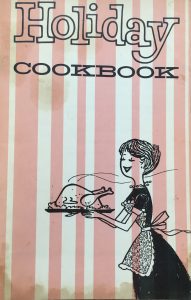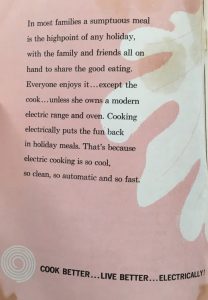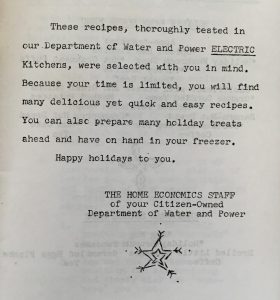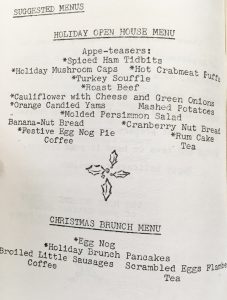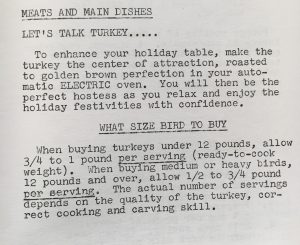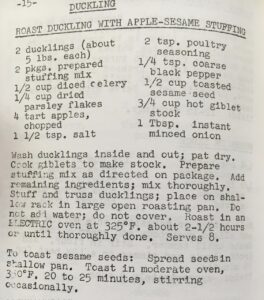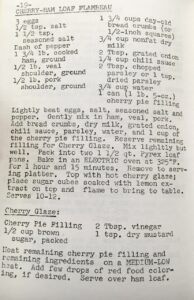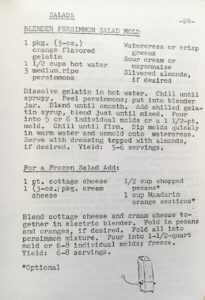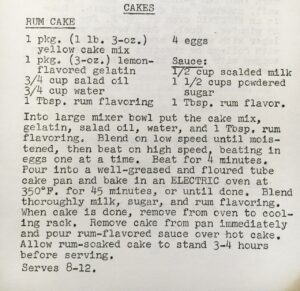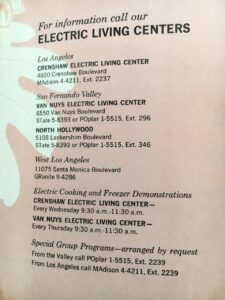The holidays are here, and home cooks everywhere are getting out their families’ traditional recipes! Maybe some are pulling out vintage cookbooks, stained with years of use. This particular cookbook from the Valley Relics Museum Collection was originally a free gift from the Los Angeles Department of Water and Power.
As well as providing tasty recipes, the point of the cookbook is to promote the ease and efficiency of electric appliances. They’ll take away all the stress from the cook! (Yeah, right.)
There is no date on this booklet, but it is most likely from the late 1950s. Our collection also includes a cookbook produced by Southern California Edison with a nearly identical slogan and appliance-pushing theme, and that one is dated 1958. However, while the SCE booklet is neatly typeset and professionally illustrated throughout, this one is a more humble affair. Apart from the cover, it is reproduced from typed pages and illustrated with tiny little doodles. I like to imagine the DWP “Home Economics Staff” putting it together. Unlike many cookbooks from the mid 20th century, not a single contributor put their name on a recipe.
The job of the Home Economics Staff, which was founded in 1950, was synonymous with the goals of the booklet: to get LA-area homeowners familiar with the advantages of a modern, all-electric kitchen and home. At their “Electric Living Center” locations on Crenshaw Blvd. and in the San Fernando Valley, they held demonstrations with local appliance dealers to show off the usefulness of the latest refrigerators, stoves, washing machines, and more. They also provided recipes (like these ones) and held seminars for the Home Ec departments of local schools. In 1980, the team was disbanded and the remaining members were folded into the DWP Public Relations sections. (Source)
Let’s get back to the recipes! Isn’t this a festive menu? It’s decadent: three “appe-teasers,” turkey and roast beef, two kinds of quick bread, and two desserts! Every recipe marked with an asterisk is included in the booklet. (I won’t reproduce all of them in this post, however.)
The recipes are interspersed with advice on how to use ELECTRIC appliances to your best advantage when planning holiday meals. Sometimes when plain advice got too dull, the Home Economists wrote little jingles instead.
Wow! I decided to skip the pages on turkey, roast beef, and baked ham in order to focus on two particularly special main courses. This one stands out for classiness and taste. In the 1960s, the popularity of Julia Child’s books and TV shows started a fad for canard à l’orange, but roast duckling was not particularly common on American holiday tables in the 50s. I can only imagine that Roast Duckling with Apple-Sesame Stuffing was the personal specialty of one of the cookbook writers. It sounds delicious.
If roast duckling was special, this recipe is one-of-a-kind. It must have been very impressive, visually: just picture it coming to the table, all cherry-red and pink in two matching turquoise blue Pyrex dishes with little snowflakes on them . . . and then adorned with flaming sugar cubes! It was probably less dry than you think, as ham and cuts of pork were once sold with more fat than is usual today. Even so, I struggle to find words for this bizarre, sweet-and-salty concoction. No, thanks.
It’s not a 1950s party without a gelatin mold! It seems a little strange today that something so sweet, featuring jell-o, fruit, and nuts, could be considered a “salad” and not a dessert, but in 1950s cookery, almost anything could be the salad course if you served it on top of greens with a dish of mayo on the side. And of course, serving a molded salad was also a great way to show off your modern kitchen—I’m a little disappointed that the person who typed up this page forgot to include the reminders to use your ELECTRIC blender and ELECTRIC freezer!
The recipe features persimmons, which are a soft, sweet fruit that ripens in early winter. Persimmon trees are easy to grow in Southern California, but not in many other parts of the country, because they don’t like frosts. That makes this recipe another fairly unique one, unlikely to be repeated in other vintage cookbooks that perhaps had a nationwide audience. I wonder if the contributor had a persimmon tree in her backyard.
There are a lot of ways to make an eggnog pie. Some are fancy and use homemade custard. Some use a box of vanilla pudding mix. And some, like this one, get their firm yet jiggly texture from gelatin! Gelatin also turns up in the rum cake, which is a variation on a classic. Many rum cake recipes today start with yellow cake mix and again, vanilla pudding mix, but this one is based on a lemon jell-o cake instead. The flavored gelatin in the batter creates a moist, lemony cake, but addition of rum flavoring in the batter and rum glaze make it very Christmas-y!
The inside back cover let Valley residents know where they could find more information about “Electric Living.” 6550 Van Nuys Blvd. is still a DWP building to this day. Over in North Hollywood, 5108 Lankershim Blvd. is now the Lankershim Arts Center and is a registered cultural landmark. If you dropped in at the Van Nuys center on a Thursday morning, the staff of Home Economists would be there, demonstrating for the public how important it is to have an ELECTRIC kitchen!
Happy holidays, everyone!
Alison Turtledove, blogger and Valley Relics Museum archivist
